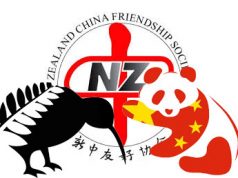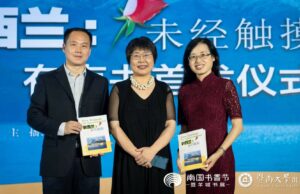NEXT BRANCH MEETING
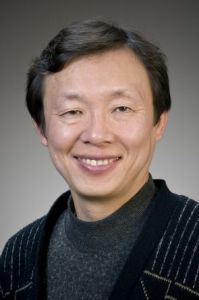 Professor James Liu will speak on “Chinese Indigenous Psychology”
Professor James Liu will speak on “Chinese Indigenous Psychology”
The global system of world governance and the global system of psychology were born in an era of exclusive Western dominance. Young educated people of the world are in agreement that agency in world history has belonged to the West and to Western ideas.
Of these ideas, among the most influential has been Liberal philosophy, with its rallying call of freedom, equality, and fraternity. While the world is much more free than it ever was, inequality rather than equality is the global norm. In this world of haves and have nots, an alternative ideology to Liberalism that I refer to as Benevolent Authority is very prevalent in the developing world, especially mainland China. I describe a new program of research on Chinese systems of Authority that question Western approaches demonizing authoritarianism as the root of all evil. Eastern (especially Confucian) approaches portray authority as benevolent with the goal of creating an ethical and moral social order based on self-cultivation rather than the law and human rights under the law. Asia, and China in particular, with its history of bureaucratic competence and moral-ethical authoritarianism, has a model for governance that cannot be ignored given the weakening of the United States and the rise of developing nations in Asia, Africa, and Latin America. All of us can contribute to the construction of global consciousness by understanding the historical basis of our indigenous cultural mentalities, and understanding the inflection points that allow for transition, change, peace and conflict between them.
James Hou-fu Liu is Professor of Psychology at Victoria University of Wellington and Deputy Director of its Centre for Applied Cross-Cultural Research. He was born in Taiwan and grew up in the Midwestern United States. He obtained a Bachelor’s Degree in Computer Science from the University of Illinois and worked as an aerospace engineer. Then he completed a PhD in psychology in 1992 at UCLA, and has been teaching at Victoria University of Wellington since 1994. His research is at the intersection of cross-cultural psychology and inter-group relations. A naturalized citizen of two countries, he describes himself as a “Chinese-American-New Zealander”.
Sunday, 17 July 2011, at 2.30 pm, Connolly Hall
Guildford Terrace, off Hill Street, Thorndon, Wellington.
(Car park up Guildford Tce beside Hall)
Followed by Afternoon Tea, gold coin donation appreciated
ALSO COMING UP THIS MONTH
9, 16 July 3:15pm Mandarin Corner, 20 Kelburn Parade
27 July 7:30pm Film Evening, 101 Wakefield St
See below for further details.
NEW MEMBERS – A warm welcome to Amanda Hillock, Ferne McKenzie and William Michael.
REPORT ON LAST MEETING (from Ray Brownrigg)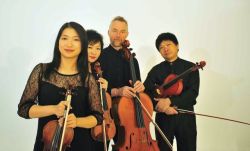
At our last meeting on Wednesday June 15 a good attendance of nearly 50 heard the Aroha String Quartet present “Our Stories and our Music”. The meeting started with President Bernie Richmond offering a special welcome to the Chinese Embassy Chargé d’Affairs Cheng Lei and his wife. The Quartet leader Haihong Liu then started their presentation by introducing herself, from Canton, having lived in NZ for 10 years, working for the NZ Symphony Orchestra. She started the Quartet in 2004 with her husband Zhongxian (Kim) Jin and NZSO violinist Beiyi Xue and cellist Jiaxin Cheng from Shanghai. The latter was replaced by the incumbent cellist Robert Ibell in 2009. Robert then described his time in the quartet and some of their recent activities, including Chamber Music study in Austria and an appearance at the Shanghai Expo last year. Finally Zhongxian Jin, from Guangzhou, described his background of having learned to play violin during the Cultural Revolution as a way of avoiding being sent to the countryside as a teenager. He described how he developed a love of teaching music, and had just realised his dream of having his own school of music in Guangzhou when he emigrated to NZ. He now performs as a casual player for the NZSO and the Wellington Vector Orchestra, while continuing his passion of teaching music.
The stories were interspersed with a range of different musical performances, ranging from a classical European composition from Szymanowski – String Quartet No. 2 Op. 56, through Chinese Opera pieces to Cultural Revolution arrangements of Chinese folk songs.
The appreciative audience kept asking for more, until the meal arrived to relieve the ever-accommodating musicians. For those who wish to hear more, the Quartet website at www.arohaquartet.com/events.html provides a list of upcoming events.
MEETING DATES FOR THE REST OF 2011
August 17, Wednesday 5.45pm: Dr Han Xi, “Chinese Teaching and Learning in Schools”
September 21, Wednesday 5.45pm: HE Mr Xu Jianguo, PRC Ambassador (topic to be confirmed)
October 19, Wednesday 5.45pm: Mr Chris Elder, “Reflections on China”
November 16, Wednesday 5.45pm: Mr David Feickert, “Mine Safety in China: Lessons for New Zealand”
Located 45 km southeast of Tianshui City in Gansu Province, Maiji Mountain rises abruptly 142 meters from the surrounding landscape. The people there named the mountain ‘Maiji’ because it resembles a stack of wheat straw (mai meaning wheat, and ji meaning stack). On the sheer cliff that marks the southwest side of Maiji Mountain, people have laboured for centuries carving niches and caves, giving rise to what is known today as the Maiji Caves. Inside the caves are clay statues, whose heights vary from 20 cm to 15 m. Besides 194 Buddhist caves and niches, containing more than 7,200 clay statues, there are also murals of over 1,300 square metres in the caves. The statues are works of art that reflect ancient craftsmanship and dedication to the Buddhist ideal. Rarely can one find caves and statues carved over sheer cliffs in China, and this is one of the most distinguishing features of the Maiji Caves. Being carved on the cliff, these caves are connected by plank roads that hang precariously along the face of the cliff. Visitors can only reach each cave by using these plank roads. Work on the Maiji Caves began in the late Qin Dynasty (221-206 BC), progressing through to the Qing Dynasty (1644-1911). Since the Qin Dynasty era, subsequent dynasties added to, and sometimes rebuilt the caves according to the styles of their era. Although the statues were built at the same location, none of them maintained a similar style with those preceding them. Statues from each dynasty clearly developed distinct elements. Also, with each succeeding era, the statues trend toward secularization, that is, a move toward depicting the icons as man rather than god. Except for statues built in the early period, almost all Buddhist statues look affable and accessible. They were no longer gods standing high in the heaven, but rather became more like common people. (From www.arts.cultural-china.com)
MANDARIN CORNER 汉语角 3.15pm – 4.30pm Saturdays during school terms
Mandarin Corner currently meets Saturdays (excluding school holidays), 3.15-4.30 pm at the Seminar Room, 20 Kelburn Parade, Victoria University of Wellington. There is a topic for each session to stimulate interest.
All welcome. Gold coin donation.
Three sessions in July: 2 July – Visit China (游中国 Check http://www.cnto.org.au for more info),
9 July – Lucky Number (吉利数字), 16 July – Guess a Riddle (猜谜游戏).
Contact: Ellen Yang, 473-7558, 027-4756888, [email protected].
CHINESE FILM 中国电影 Date: Wednesday 27 July Time: 7.00pm – 9:30pm
Venue: Committee Room One, Wellington City Council, 101 Wakefield Street
Life Show (生活秀), director Huo Jianqi霍建起, starring Tao Hong, Tao Zeru (主演: 陶红 / 陶泽如 / 潘粤明)
105 minutes. Adapted from a famous novel written by novelist Chi Li, Life Show tells the story of Lai Shuang Yang, who runs a restaurant in a Chongqing night market, with a real-life-touching story and filming techniques. It praises and successfully portrays the resilience of a Chinese woman Lai who lives in revolutionary China.
CONFUCIUS INSTITUTE NEWS (from Luke Qin 秦瞳)
1) With a series of cultural events spreading across the Wellington area in the past few months, CIVUW has been promoting the Chinese language in the meantime. On 2nd June, Dr Chen Ben opened the first Chinese course “Approaching China” 《走近中国》 for New Zealand Trade and Enterprise (NZTE), pictured at right. This is a comprehensive course aimed at teaching basic Chinese as well as delivering the essential everyday business etiquette & language skills in the hope that the learners will have some general knowledge of China before taking up their business trips there.
 2) During June 10-16, CIVUW held a one-week Chinese Exhibition in Wanganui High School (WHS), the last stop of the Chinese Exhibition Tour of CIVUW Chinese Cultural Festival. WHS started to teach Chinese in early 1995 and now has nearly 80 learners. In addition, WHS has set up a Chinese Corner in its library to offer its students a “garden” of Chinese language and culture, and keeps an ongoing friendly relationship with the No. 13 High School of Xuzhou in Jiangsu Province, China. Through this initiative, students of both schools may visit each other and experience the unique culture of both countries. Pictured left is Dr Chen Ben with WHS students.
2) During June 10-16, CIVUW held a one-week Chinese Exhibition in Wanganui High School (WHS), the last stop of the Chinese Exhibition Tour of CIVUW Chinese Cultural Festival. WHS started to teach Chinese in early 1995 and now has nearly 80 learners. In addition, WHS has set up a Chinese Corner in its library to offer its students a “garden” of Chinese language and culture, and keeps an ongoing friendly relationship with the No. 13 High School of Xuzhou in Jiangsu Province, China. Through this initiative, students of both schools may visit each other and experience the unique culture of both countries. Pictured left is Dr Chen Ben with WHS students.
China will expand its offshore wind power installed capacity to 5 gigawatts (GW) by 2015 and 30 GW by 2020, said the Chinese Renewable Energy Industries Association (CREIA) in early June, 2011. To date, China, the world’s largest wind power developer, with a total of 44.7 GW wind turbine installed capacity at the end of 2010, has accelerated developing offshore wind power. Offshore wind development in China remains in the early stages due to complex operating environments for offshore turbines, high technological requirements and construction difficulties, according to Qin Haiyan, secretary general of the China Wind Energy Association. In 2009, China had only 63,000 kilowatts offshore wind turbines installed, about 21 percent of the newly installed offshore wind power in the UK, the fastest growing country of that year. The year 2010 marked the start of China’s offshore wind power sector’s transition from research and pilot projects to operational wind farms. In March 2010, Shi Lishan, deputy director of the New Energy and Renewable Energy Department of the National Energy Bureau (NEB), said top priority would be given to developing offshore wind power projects in the course of boosting the flourishing wind power industry. In June 2010, the first stage project of the East Sea Bridge Offshore Wind Farm went into operation in Shanghai. Totaling 102 megawatts (MW), it is China’s first large-scale offshore wind farm, located to the east side of the Shanghai East Sea Bridge. It comprises 34 units of 3 MW turbines. Offshore wind power construction is a priority in China in 2011. In January, the NEB said China would kick off construction of 1 GW offshore wind power projects. The public tender for the 1 GW offshore concession projects, totaling four wind farms in China’s Jiangsu Province, was announced in October 2010. The China Meteorological Administration has estimated China’s offshore wind potential at more than 750 GW – far higher than the 253 GW potential for land-based wind. China’s eastern coastal areas, particularly Jiangsu Province, boast sound conditions to develop wind farms on beaches and in offshore areas. As these coastal provinces are largely the economic engines of the country, raising great demands for electric power but running short of fossil energy sources, their suitability for wind power generation is very fortunate. (From www.pathwaytochina.com, with minor editing)
IDIOM OF THE MONTH (from Ana Baide)
有志者事竟成 (yǒu zhì zhě shì jìng chéng) where there is a will there is a way
TRADITIONAL LI TEXTILE TECHNIQUES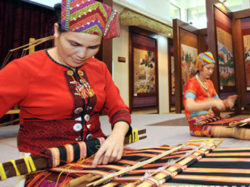
The traditional Li textile techniques of spinning, dyeing, weaving and embroidering are employed by women of the Li ethnic group of Hainan Province, China, to make cotton, hemp and other fibres into clothing and other daily necessities. The techniques involved, including warp ikat, double-face embroidery, and single-face jacquard weaving, are passed down from mothers to daughters from early childhood through verbal instruction and personal demonstration. Li women design the textile patterns using only their imagination and knowledge of traditional styles. In the absence of a written language, these patterns record the history and legends of Li culture as well as aspects of worship, taboos, beliefs, traditions and folkways. The patterns also distinguish the five major spoken dialects of Hainan Island. The textiles form an indispensable part of important social and cultural occasions such as religious rituals and festivals, and in particular weddings, for which Li women design their own dresses. As carriers of Li culture, traditional Li textile techniques are an indispensable part of the cultural heritage of the Li ethnic group.
However, in recent decades the numbers of women with the weaving and embroidery skills at their command has severely declined to the extent that traditional Li textile techniques are exposed to the risk of extinction and are in urgent need of protection. (from the UNESCO Culture Sector – Intangible Heritage)
XINHAI REVOLUTION – CENTENARY (from Luke Qin 秦瞳)
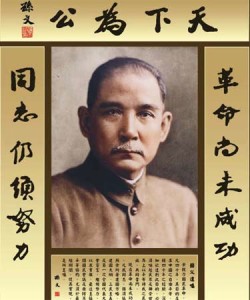 The Xinhai Revolution or Hsinhai Revolution (辛亥革命), also known as the Revolution of 1911 or the Chinese Revolution, began with the Wuchang Uprising on October 10, 1911 and ended with the abdication of Emperor Puyi on February 12, 1912. The revolution is named after in the sexagenary cycle of the Chinese calendar; the Xinhai Year. The revolution was motivated by anger at corruption in the Qing government, frustration with the government’s inability to restrain the interventions of foreign powers. The revolutionaries wanted to overthrow the Qing government, and construct a republic. The Tongmenghui, founded in 1905, advocated “expelling the Manchus, restoring the Han, founding a republic and equally dividing the land ownership”, which referred to the famous Three Principles of the People (三民主义), Nationalism, Democracy, and Socialism) promoted by Sun Yat-sen. On 1 January 1912, Sun Yat-sen announced the establishment of the Republic of China in Nan Jing (Nanking), and he was inaugurated as the Provisional President. In the “Inaugural Announcement of Provisional President”, the unity of Chinese races as one was greatly emphasized. On 2 January 1912, Sun Yat-sen informed all provinces that the Yin (Lunar) calendar had been abolished and that it had been replaced by the Yang (Solar) calendar. The Xinhai Revolution overthrew the Qing government and 4,000 years of monarchy. Throughout Chinese history, old dynasties had always been replaced by new dynasties. The Xinhai Revolution, however, was the first to overthrow a monarchy completely and attempt to establish a Republic.
The Xinhai Revolution or Hsinhai Revolution (辛亥革命), also known as the Revolution of 1911 or the Chinese Revolution, began with the Wuchang Uprising on October 10, 1911 and ended with the abdication of Emperor Puyi on February 12, 1912. The revolution is named after in the sexagenary cycle of the Chinese calendar; the Xinhai Year. The revolution was motivated by anger at corruption in the Qing government, frustration with the government’s inability to restrain the interventions of foreign powers. The revolutionaries wanted to overthrow the Qing government, and construct a republic. The Tongmenghui, founded in 1905, advocated “expelling the Manchus, restoring the Han, founding a republic and equally dividing the land ownership”, which referred to the famous Three Principles of the People (三民主义), Nationalism, Democracy, and Socialism) promoted by Sun Yat-sen. On 1 January 1912, Sun Yat-sen announced the establishment of the Republic of China in Nan Jing (Nanking), and he was inaugurated as the Provisional President. In the “Inaugural Announcement of Provisional President”, the unity of Chinese races as one was greatly emphasized. On 2 January 1912, Sun Yat-sen informed all provinces that the Yin (Lunar) calendar had been abolished and that it had been replaced by the Yang (Solar) calendar. The Xinhai Revolution overthrew the Qing government and 4,000 years of monarchy. Throughout Chinese history, old dynasties had always been replaced by new dynasties. The Xinhai Revolution, however, was the first to overthrow a monarchy completely and attempt to establish a Republic.
NEW NEWSLETTER CONTRIBUTORS – LUKE QIN 秦瞳
Luke Qin is the newest addition to our Newsletter editing team. Luke arrived in New Zealand as an international student in 2003 when he was 18 and played 1st XV rugby for Linwood College in his first year in New Zealand without knowing that he couldn’t tackle players who didn’t have the ball. After spending some 7 years as a one-eyed Cantabrian he now works as a Business Manager at BNZ specializing in SME in the Wellington region. Luke is a member of the Asia NZ Foundation Young Leaders’ Network and actively involved in the community.
BOOK CORNER (from Ana Baide)
Non Fiction
The Importance of Living, by Lin Yutang, Cultured Lotus, 2001 (First published by the John Day Company 1937). A collection of essays on the art of living in consideration of eastern and western ways.
(Lin Yutang (1895-1976) was one of the most influential writers of his generation. Many of his compilations and translations of classic Chinese texts into English were bestsellers on the West)




